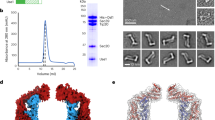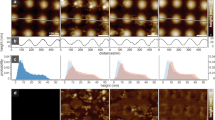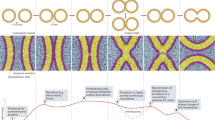Abstract
SNARE proteins are essential for intracellular membrane fusion of eukaryotes. Their assembly into stable four-helix bundles bridges membranes and may provide the energy for initiating membrane fusion. In vitro, assembly of soluble SNARE fragments is accompanied by major structural rearrangements that can be described as a folding reaction. The pathways and the thermodynamics of SNARE protein interactions, however, are not known. Here we report that assembly and dissociation of two distantly related SNARE complexes exhibit a marked hysteresis. The assembled and disassembled native states are separated by a kinetic barrier and cannot equilibrate on biologically relevant timescales. We suggest that the hysteresis is a hallmark of all SNARE complexes and that complex assembly and disassembly follow different pathways that may be independently controlled.
This is a preview of subscription content, access via your institution
Access options
Subscribe to this journal
Receive 12 print issues and online access
$189.00 per year
only $15.75 per issue
Buy this article
- Purchase on Springer Link
- Instant access to full article PDF
Prices may be subject to local taxes which are calculated during checkout






Similar content being viewed by others
References
Palade, G. Intracellular aspects of the process of protein synthesis. Science 189, 347–358 (1975).
Zimmerberg, J. & Chernomordik, L.V. Membrane fusion. Adv. Drug. Deliv. Rev. 38, 197–205 (1999).
Lentz, B.R., Malinin, V., Haque, M.E. & Evans, K. Protein machines and lipid assemblies: current views of cell membrane fusion. Curr. Opin. Struct. Biol. 10, 607–615 (2000).
Jahn, R. & Südhof, T.C. Membrane fusion and exocytosis. Annu. Rev. Biochem. 68, 863–911 (1999).
Lin, R.C. & Scheller, R.H. Mechanisms of synaptic vesicle exocytosis. Annu. Rev. Cell Dev. Biol. 16, 19–49 (2000).
Hanson, P.I., Heuser, J.E. & Jahn, R. Neurotransmitter release - four years of SNARE complexes. Curr. Opin. Neurobiol. 7, 310–315 (1997).
Weber, T. et al. SNAREpins: minimal machinery for membrane fusion. Cell 92, 759–772 (1998).
Ungermann, C., Sato, K. & Wickner, W. Defining the functions of trans-SNARE pairs. Nature 396, 543–548 (1998).
Peters, C. & Mayer, A. Ca2+/calmodulin signals the completion of docking and triggers a late step of vacuole fusion. Nature 396, 575–580 (1998).
Peters, C. et al. Trans-complex formation by proteolipid channels in the terminal phase of membrane fusion. Nature 409, 581–588 (2001).
Misura, K.M., May, A.P. & Weiss, W.I. Protein-protein interactions in intracellular membrane fusion. Curr. Opin. Struct. Biol. 10, 662–671 (2000).
Brünger, A.T. Structural insights into the molecular mechanism of calcium-dependent vesicle-membrane fusion. Curr. Opin. Struct. Biol. 11, 163–73 (2001).
Fasshauer, D., Bruns, D., Shen, B., Jahn, R. & Brünger, A.T. A structural change occurs upon binding of syntaxin to SNAP-25. J. Biol. Chem. 7, 4582–4590 (1997).
Fasshauer, D., Otto, H., Eliason, W.K., Jahn, R. & Brünger, A.T. Structural changes are associated with soluble N-ethylmaleimide-sensitive fusion protein attachment protein receptor complex formation. J. Biol. Chem. 272, 28036–28041 (1997).
Fasshauer, D., Eliason, W.K., Brünger, A.T. & Jahn, R. Identification of a minimal core of the synaptic SNARE complex sufficient for reversible assembly and disassembly. Biochemistry 37, 10354–10362 (1998).
Fiebig, K.M., Rice, L.M., Pollock, E. & Brünger, A.T. Folding intermediates of SNARE complex assembly. Nature Struct. Biol. 6, 117–123 (1999).
Hazzard, J., Sudhof, T.C. & Rizo, J. NMR analysis of the structure of synaptobrevin and of its interaction with syntaxin. J. Biomol. NMR 14, 203–207 (1999).
Margittai, M., Fasshauer, D., Pabst, S., Jahn, R. & Langen, R. Homo- and heterooligomeric snare complexes studied by site-directed spin labeling. J. Biol. Chem. 276, 13169–77. (2001).
Sutton, R.B., Fasshauer, D., Jahn, R. & Brünger, A.T. Crystal structure of a SNARE complex involved in synaptic exocytosis at 2.4 Å resolution. Nature 395, 347–53 (1998).
Fasshauer, D., Sutton, R.B., Brünger, A.T. & Jahn, R. Conserved structural features of the synaptic fusion complex: SNARE proteins reclassified as Q- and R-SNAREs. Proc. Natl. Acad. Sci. USA 95, 15781–15786 (1998).
Rice, L.M., Brennwald, P. & Brünger, A.T. Formation of a yeast SNARE complex is accompanied by significant structural changes. FEBS Lett. 415, 49–55 (1997).
Nicholson, K.L. et al. Regulation of SNARE complex assembly by an N-terminal domain of the t-SNARE Sso1p. Nature Struct. Biol. 5, 793–802 (1998).
Munson, M., Chen, X., Cocina, A.E., Schultz, S.M. & Hughson, F.M. Interactions within the yeast t-SNARE sso1p that control SNARE complex assembly. Nature Struct. Biol. 7, 894–902 (2000).
Antonin, W. et al. A SNARE complex mediating fusion of late endosomes defines conserved properties of SNARE structure and function. EMBO J. 19, 6453–6464 (2000).
Xiao, W., Poirier, M.A., Bennett, M.K. & Shin, Y.K. The neuronal t-SNARE complex is a parallel four-helix bundle. Nature Struct. Biol. 8, 308–311 (2001).
Hayashi, T. et al. Synaptic vesicle membrane fusion complex: action of clostridial neurotoxins on assembly. EMBO J. 13, 5051–5061 (1994).
Anfinsen, C.B. Principles that govern the folding of protein chains. Science 181, 223–230 (1973).
Dill, K.A. Folding proteins: finding a needle in a haystack. Curr. Opin. Struct. Biol. 3, 99–103 (1993).
Baker, D. & Agard, D.A. Kinetics versus thermodynamics in protein folding. Biochemistry 33, 7505–7509 (1994).
Plaza del Pino, I.M., Ibarra-Molero, B. & Sanchez-Ruiz, J.M. Lower kinetic limit to protein thermal stability: a proposal regarding protein stability in vivo and its relation with misfolding diseases. Proteins 40, 58–70 (2000).
Sinclair, J.F., Ziegler, M.M. & Baldwin, T.O. Kinetic partitioning during protein folding yields multiple native states. Nature Struct. Biol. 1, 320–326 (1994).
Lai, Z., McCulloch, J., Lashuel, H.A. & Kelly, J.W. Guanidine hydrochloride-induced denaturation and refolding of transthyretin exhibits a marked hysteresis: equilibria with high kinetic barriers. Biochemistry 36, 10230–10239 (1997).
Fasshauer, D., Antonin, W., Margittai, M., Pabst, S. & Jahn, R. Mixed and non-cognate SNARE complexes. Characterization of assembly and biophysical properties. J. Biol. Chem. 274, 15440–15446 (1999).
Poirier, M.A. et al. Protease resistance of syntaxin.SNAP-25.VAMP complexes. Implications for assembly and structure. J. Biol. Chem. 273, 11370–11377 (1998).
Pace, C.N. The stability of globular proteins. CRC Crit. Rev. Biochem. 3, 1–43. (1975).
Acknowledgements
The authors are very much indebted to K. Fiebig for pointing out in the beginning of the study that the observed hysteresis could be due to a folding intermediate. We thank M. Margittai, R. Langen, D. Bruns, T. Heimburg, S. Pabst, V. Knecht, G. Schröder and H. Grubmüller for stimulating discussions, suggestions and critical reading of the manuscript.
Author information
Authors and Affiliations
Corresponding author
Rights and permissions
About this article
Cite this article
Fasshauer, D., Antonin, W., Subramaniam, V. et al. SNARE assembly and disassembly exhibit a pronounced hysteresis. Nat Struct Mol Biol 9, 144–151 (2002). https://doi.org/10.1038/nsb750
Received:
Accepted:
Published:
Issue Date:
DOI: https://doi.org/10.1038/nsb750
This article is cited by
-
Mechanisms of SNARE proteins in membrane fusion
Nature Reviews Molecular Cell Biology (2024)
-
Resolving kinetic intermediates during the regulated assembly and disassembly of fusion pores
Nature Communications (2020)
-
Mapping the energy landscapes of supramolecular assembly by thermal hysteresis
Nature Communications (2018)
-
Chaperoning SNARE assembly and disassembly
Nature Reviews Molecular Cell Biology (2016)
-
Insights into open/closed conformations of the catalytically active human guanylate kinase as investigated by small-angle X-ray scattering
European Biophysics Journal (2016)



